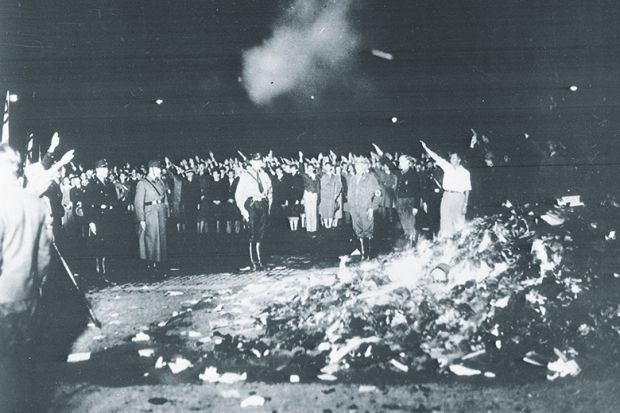It is now common to associate Hitler’s dictatorship with many forms of repression, including the broad use of censorship. Indeed, long before his appointment in January 1933, he and his comrades promised that they would cleanse the nation of the decadence they saw in all the arts and sciences. Although the democratic Weimar Republic had abolished censorship in its constitution, on 25 March 1930 its parliament revised the law for the protection of the republic. Henceforth the government had the right to dissolve organisations and limit speech, and this was easily abused. Decrees soon followed that allowed banning books for up to eight months, and another decree could stop publications deemed to be “untrue” or to have used “distorted facts” that slandered leading state officials. Thus, Germany was already losing its liberal self-confidence in the last days of Weimar, and these measures opened the door for the clampdown the Nazis had in mind.
Hitler set the regime’s tone in a speech after the Reichstag fire at the end of February 1933 when he promised to lead a “thoroughgoing moral renewal” to preserve the nation’s values. Yet he remained ambivalent about banning books, mostly kept his distance, and left the details to others. Although the regime did indeed introduce wide-ranging censorship, it did so more haphazardly then we might expect. The first sustained attack began at the grassroots level in April and May, when university students took the lead in digging out books thought to reflect an “un-German spirit”, and then burning them in public ceremonies. Occasionally, the Hitler Youth engaged in similar activities in schools. However, Joseph Goebbels, Hitler’s propaganda minister, gave but one speech on the subject, and he was not the initiator of the 93 book burnings carried out in 70 cities, stretched out over two months. We can imagine the sobering effect these displays must have had in a nation of book-lovers.
When these fires cooled, what followed were more discreet forms of censorship – although it was deemed too negative-sounding a word to be used, and official pronouncements spoke only of “harmful and undesirable” books or authors. Book buyers were never to be told that a publication was prohibited, only “no longer available”. The regime proscribed a total of 5,485 titles, although locally the authorities seized even more. Goebbels’ new ministry took charge of censorship by way of a new Reich Chamber of Literature, excluding on average 300 authors per year during the peacetime years, and even more after 1939. In addition, a whole host of other bureaucrats became involved, including those in Alfred Rosenberg’s new office to promote German literature, the party commission to protect National Socialist writings, and even the Gestapo, which could act on its own, although it spurned publishers who tried to get it to vet manuscripts in advance. If the result was disarray in the censorship process, nevertheless the system worked only too well once it was up and running.
Lewy, a veteran political scientist, skilfully traces this complex story, and also assesses the impact of censorship on the writers who stayed in Germany and worked in “inner exile”. Readers will appreciate the new information and the fresh perspectives the author provides on the machinations of the Third Reich.
Robert Gellately is Earl Ray Beck professor of history, Florida State University.
Harmful and Undesirable: Book Censorship in Nazi Germany
By Guenter Lewy
Oxford University Press, 280pp, £19.99
ISBN 9780190275280
Published 27 October 2016




